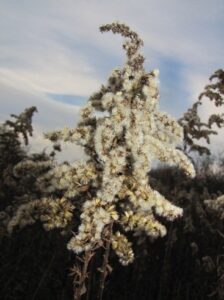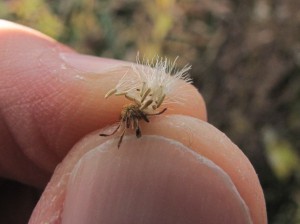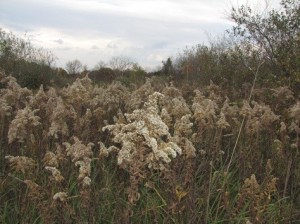YOUR DAILY DOSE OF BOTANY – NOVEMBER 2012
Pappus
by Scott Namestnik, snamestnik@orbisec.com
It’s fall, and the yellow glow of old-fields has given way to the grayish-white cast we associate with fields in winter. Of course, the yellow glow comes from goldenrod (Solidago spp.) in flower, but what gives fields the grayish-white cast when the leaves start to drop?
As discussed a couple of months ago in this column, goldenrods are in the family Asteraceae. A characteristic of this family is that the calyx (the floral part that surrounds the petals) is modified into a structure called a pappus. Pappi come in all shapes, textures, colors, and sizes. Some taxa in the family Asteraceae, such as yellow coneflower (Ratibida pinnata), lack a pappus entirely. In the genus Bidens (tickseeds), the pappus consists of barbed awns. In chicory (Cichorium intybus), the pappus is scale-like. In the goldenrods, the pappus is a group of bristles that together give a fluffy appearance. As the flowers on plants in the family Asteraceae mature, achenes (the fruit) develop, topped in most genera by the pappi. Thus, the grayish-white cast that persists in fields through the winter is created by the fluffy pappi of the infructescence of goldenrods and other composites.
The pappus has a very important role for many plants in the family Asteraceae. In goldenrods and dandelions (Taraxacum spp.), the fluffy pappus allows the fruit to blow in the wind. In tickseeds, the barbed awn pappus allows the achene to stick in the fur of animals (or the pants of botanists), allowing them to hitch a ride and find a new place to germinate. The pappus, therefore, is very important for many members of the family Asteraceae as a means of seed dispersal.
 The various types and forms of pappi provide something to investigate all winter long. Be sure to take out a hand lens and check out the different types of pappi in composites as you look forward to the coming spring.
The various types and forms of pappi provide something to investigate all winter long. Be sure to take out a hand lens and check out the different types of pappi in composites as you look forward to the coming spring.
If you have a question about plant terminology or morphology that you would like answered in a future edition of this column, send me an email at snamestnik@orbisec.com. I may not be able to address all requests given the space allotted for this column, but I will answer those that I can.

